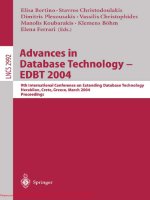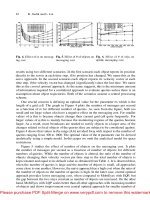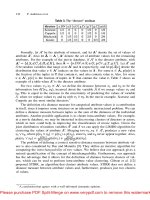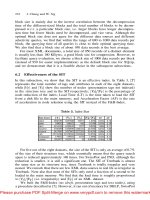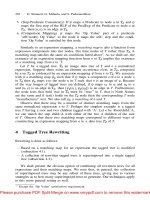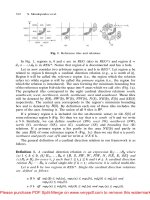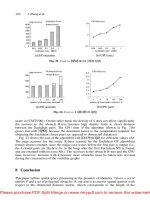Tài liệu ADVANCES IN QUANTITATIVE ANALYSIS OF FINANCE AND ACCOUNTING Essays in Microstructure in Honor of David K. Whitcomb Volume 3 ppt
Bạn đang xem bản rút gọn của tài liệu. Xem và tải ngay bản đầy đủ của tài liệu tại đây (1.88 MB, 269 trang )
ADVANCES IN QUANTITATIVE ANALYSIS OF
FINANCE AND
ACCOUNTING
Essays in Microstructure in Honor of David K. Whitcomb
Volume 3
This page intentionally left blankThis page intentionally left blank
ADVANCES IN QUANTITATIVE ANALYSIS OF
FINANCE AND
ACCOUNTING
Essays in Microstructure in Honor of David K. Whitcomb
Volume 3
Editors
Ivan E. Brick
Rutgers University, USA
Tavy Ronen
Rutgers University, USA
Cheng-Few Lee
Rutgers University, USA
World Scientific
NEW JERSEY . LONDON . SINGAPORE . BEIJING . SHANGHAI . HONG KONG . TAIPET. CHENNAI
British Library Cataloguing-in-Publication Data
A catalogue record for this book is available from the British Library.
For photocopying of material in this volume, please pay a copying fee through the Copyright
Clearance Center, Inc., 222 Rosewood Drive, Danvers, MA 01923, USA. In this case permission to
photocopy is not required from the publisher.
ISBN 981-256-626-0
Typeset by Stallion Press
Email:
All rights reserved. This book, or parts thereof, may not be reproduced in any form or by any means,
electronic or mechanical, including photocopying, recording or any information storage and retrieval
system now known or to be invented, without written permission from the Publisher.
Copyright © 2006 by World Scientific Publishing Co. Pte. Ltd.
Published by
World Scientific Publishing Co. Pte. Ltd.
5 Toh Tuck Link, Singapore 596224
USA office: 27 Warren Street, Suite 401-402, Hackensack, NJ 07601
UK office: 57 Shelton Street, Covent Garden, London WC2H 9HE
Printed in Singapore.
ADVANCES IN QUANTITATIVE ANALYSIS OF FINANCE AND ACCOUNTING
VOLUME 3
Essays in Microstructure in Honor of David K Whitcomb
March 14, 2006 15:23 WSPC/B351 content.tex
Preface to Volume 3
Advances in Quantitative Analysis of Finance and Accounting is an annual
publication designed to disseminate developments in the quantitative analy-
sis of finance and accounting. The publication is a forum for statistical and
quantitative analyses of issues in finance and accounting as well as applica-
tions of quantitative methods to problems in financial management, financial
accounting, and business management. The objective is to promote interaction
between academic research in finance and accounting and applied research in
the financial community and the accounting profession.
This volume contains eleven papers in microstructure. These papers have
been classified into three sections: i) Economics of Limit Orders, ii) Essays on
Liquidity of Market, and iii) Market Rationality. The overall highlight of these
papers can be found in the introduction written by Ivan Brick and Tavy Ronen.
v
FA1
March 14, 2006 15:23 WSPC/B351 content.tex
This page intentionally left blankThis page intentionally left blank
March 14, 2006 15:23 WSPC/B351 content.tex
Contents
Preface to Volume 3 v
Introduction to Volume 3 ix
Ivan E. Brick, Tavy Ronen
List of Contributors xv
Section I — Economics of Limit Orders
Chapter 1 Discriminatory Limit Order Books,
Uniform Price Clearing and Optimality 3
Lawrence R. Glosten
Chapter 2 Electronic Limit Order Books and Market
Resiliency: Theory, Evidence, and Practice 19
Mark Coppejans, Ian Domowitz, Ananth Madhavan
Chapter 3 Notes for a Contingent Claims Theory of Limit
Order Markets 39
Bruce N. Lehmann
Chapter 4 The Option Value of the Limit Order Book 57
Alex Frino, Elvis Jarnecic, Thomas H. McInish
Section II — Essays on Liquidity of Markets
Chapter 5 The Cross Section of Daily Variation in Liquidity 75
Tarun Chordia, Lakshmanan Shivakumar,
Avanidhar Subrahmanyam
vii
FA1
March 14, 2006 15:23 WSPC/B351 content.tex
viii Contents
Chapter 6 Intraday Volatility on the NYSE and NASDAQ 111
Daniel G. Weaver
Chapter 7 The Intraday Probability of Informed
Trading on the NYSE 139
Michael A. Goldstein, Bonnie F. Van Ness,
Robert A. Van Ness
Chapter 8 Leases, Seats, and Spreads: The Determinants
of the Returns to Leasing a NYSE Seat 159
Thomas O. Miller, Michael S. Pagano
Chapter 9 Decimalization and Market Quality 175
Robin K. Chou, Wan-Chen Lee
Section III — Market Rationality
Chapter 10 The Importance of Being Conservative:
An Illustration of Natural Selection in a
Futures Market 197
Guo Ying Luo
Chapter 11 Speculative Non-Fundamental Components
in Mature Stock Markets: Do they Exist and
are they Related? 217
Ramaprasad Bhar, A. G. Malliaris
Index 247
FA1
March 21, 2006 9:27 WSPC/B351 intro.tex
Introduction
Ivan E. Brick and Tavy Ronen
Rutgers University, USA
Once an obscure subfield of finance, Market Microstructure has emerged as
a major stream of finance. In its narrowest sense, microstructure might be
defined as the study of the level and the source of transactions costs associated
with trading. It examines the organizational structure of exchanges and how the
specific market structure enhances the efficiency, transparency and information
dissemination of security trading. In a broader sense, this field has opened
new methods and directions from which to examine pre-existing theories and
puzzles in finance, in both the investments and corporate finance areas. It has
seemingly created the most innovative and popular link between the two areas.
In such, it can be viewed as way of thought, as opposed to a subfield.
A major contribution of microstructure can be seen in the advancement of
our understanding of market efficiency. In particular, we can now use intraday
data to examine the speed of information incorporation into security prices
when major corporate announcements take place. Similarly, our understanding
of asset pricing has been altered with the advent of high frequency data anal-
ysis. Traditional asset pricing models focus on the formation of equilibrium
security prices based upon the moments of distribution of the underlying cash
flows of the security and attribute changes in security prices to changes in infor-
mation structure of the market. In contrast, market microstructure recognizes
that the actual transaction prices and variances do not necessarily equal those
determined by our financial models. Thus, the emphasis of market microstruc-
ture becomes the study of the deviations between the transaction price and the
equilibrium price, with deviations attributed to such factors as liquidity, mar-
ket structure, transaction costs, and inventory-based adjustments. Clearly, the
growing body of research in this field has uncovered and revisited many of our
traditional theories, shedding new light on the interpretation of our markets.
This book is a tribute to the field of microstructure and to David K.
Whitcomb, Professor Emeritus at Rutgers University, who is one of its fore-
most pioneers. Like the field itself, David Whitcomb’s contributions have had
an impact both in their academic rigor and practical applications. His articles
ix
FA3
March 21, 2006 9:27 WSPC/B351 intro.tex
x Ivan E. Brick & Tavy Ronen
have appeared in The American Economic Review, The International Journal
of Finance, The Journal of Banking and Finance, The Journal of Finance,
The Journal of Financial Economics, The Journal of Financial & Quantitative
Analysis, The Journal of Industrial Economics, The Journal of Money, Credit
& Banking, The Journal of Political Economy, Management Science, and The
Review of Economics and Statistics. He is author of one book, Externalities
and Welfare (Columbia University Press, 1972), and co-author of two others,
The Microstructure of Securities Markets (Prentice-Hall, February 1986), and
Transaction Costs and Institutional Investor Trading Strategy (Salomon Broth-
ers Center for the Study of Financial Institutions Monograph Series, 1988).
Besides his principal research interest in market microstructure, his other
research interests include credit market theory, industrial organization, and
economic theory. He is listed as one of the leading researchers in financial eco-
nomics as measured by citations to his research in leading financial economics
journals over the 25 years — 1974 to 1998 (see Chung, Cox, and Mitchell,
“Citation Patterns in the Finance Literature,” Financial Management, 2001).
Dave Whitcomb served as a faculty member in the Finance and Economics
department at the Rutgers Business School for over 25 years, until he retired in
1999 as Professor Emeritus. Today, he devotes himself to Automated Trading
Desk Inc. (ATD), the “microstructure” company he founded. ATD’s brokerage
subsidiary now trades over 65 million shares per day, mostly in the NASDAQ
market and mostly via fully automated limit orders. Automated Trading Desk
Inc. is the first expert system for fully automated limit order trading of common
stocks. ATD is located in Mt. Pleasant, SC, has 50 full time employees and a
subsidiary broker–dealer firm holding membership in the NASD, and trades
about 65 million shares/day (over 2% of total NASDAQ volume). Whitcomb
won the regional 2001 Entrepreneur of the Year award (sponsored by Ernst &
Young, USA Toda, and NASDAQ) for financial services for the Carolinas.
In October 2002, we (Ivan Brick and Tavy Ronen) and Michael Long orga-
nized a conference at the Rutgers Business School of Rutgers University in
honor of David K. Whitcomb. The conference was sponsored by the Whitcomb
Center for Research in Financial Services. This conference showcased papers
and research conducted by the leading luminaries in the field of microstructure
and drew a broad and illustrious audience of academicians, practitioners and
former students, all who came to pay tribute to David.
This book is a collection of 11 original studies in the field of microstructure,
the first seven of which were presented at the conference in October 2002,
FA3
March 21, 2006 9:27 WSPC/B351 intro.tex
Introduction xi
across different subareas, and each reflecting the future directions of research.
We have loosely divided the book into three sections: Economics of Limit
Orders, Essays on Liquidity of Markets and Market Rationality.
The first section of the book addresses the important issue of optimal limit
order book structure. This is a central focus of the microstructure literature
today, in part because of the growing use of the limit order book in most major
exchanges and markets, both domestically and internationally, in the trade of
equities, derivatives, bonds, and foreign exchange. The chapters in this book
that examine the optimality of the limit order book, as well as its character-
istics and resulting efficiency all take a different perspective in analyzing this
increasingly popular market mechanism. “Single Price Limit Order Books,
Discriminatory Limit Order Books, and Optimality,” by Lawrence Glosten
establishes that the limit order book is not only inevitable, as suggested by his
earlier paper, “Is the electronic limit order book inevitable?” (Glosten, Journal
of Finance, September 1994), but also optimal in most instances. The analysis
incorporates asymmetric information, inventory related costs and potential liq-
uidity difficulties in the derivation and characterization of the equilibrium. The
paper shows that a Centralized Limit order book is indeed optimal, implying
that if a regulatory authority could choose and protect a single market mecha-
nism, it would most probably choose the limit order book mechanism. Another
interesting result of the paper is that a uniform price clearing mechanism can
never be optimal in a setting where private information is present. The negative
profits that Glosten shows to exist in such an environment are surprising in
light of the fact that opening clearings on most exchanges use a uniform price
procedure.
The second paper in this section, “Electronic Limit Order Books and Mar-
ket Resiliency: Theory, Evidence, and Practice,” by Mark Coppejans, Ian
Domowitz, and Ananth Madhavan further addresses the question of market
design by examining the liquidity provision of electronic limit order books.
This is an important feature for market structure to consider, since despite the
advantages of speed and simplicity attributed to automated auctions, a relevant
concern is whether the lack of designated dealers compromise the consistency
of liquidity levels. This paper develops a theoretical model to predict the impact
of economic shocks on the resiliency of the limit order book system. Resiliency
is defined as the speed with which the market absorbs economic shocks. The
paper uses data from actual trade executions of an automated index futures
market limit order book. While volatility shocks are found to reduce liquidity,
FA3
March 21, 2006 9:27 WSPC/B351 intro.tex
xii Ivan E. Brick & Tavy Ronen
the liquidity shocks dissipate quickly, implying that the electronic order limit
book system is highly resilient. The policy implications of these findings are
immediate: While trading halts following sharp market movements are desir-
able for efficient price discovery, they need not necessarily be long in duration
to achieve their goal. Further, the results of this paper imply that informed
traders take advantage of the depth reported by electronic limit order books to
break up their trades and thereby minimize price impact of their trades.
The third paper in the limit order book section, “Notes on a Contingent
Claims Theory of Limit Order Valuation” by Bruce Lehmann illustrates that
limit order markets can create windows of opportunity for traders to pocket
arbitrage profits if price priority rules govern order matching. These profits can
be captured by simultaneously writing calls and placing a limit buy order, which
in turn can be seen as a call option on a stock. The investor’s profit is then the
call option premium, assuming frictionless markets. Interestingly, the inclusion
of time priority as a secondary execution rule does not completely eliminate
potential arbitrage profit. This paper illustrates examples in which event time
and calendar time differ but can coincide such as to precede continuous trading
in most equity markets. The economics involve assuming that limit order traders
(as suppliers of liquidity) span desired trading in event time.
In “The Option Value of the Limit Order Book,” by Alex Frino, Elvis
Jarnecic and Thomas H. McInish, the option value of the limit order book
is calculated for a sample of ten actively traded stocks from the Australia Stock
Exchange at 11 a.m. each day. The authors find that the option value of the
limit order book is stable for the 11 a.m. snapshot over the sample period of
September 3 to December 31, 2001. Interestingly, they also find that 33.1% of
the option value of the limit order book is provided at the best ask and 34.7% at
the best bid. Moreover, the paper concludes that the option value of the entire
limit order book is more stable than both the value of an individual limit order
option and the number of shares in the limit order book during that time period.
The second section of the book deals with the liquidity of capital mar-
kets. The first chapter of this section is “The Cross-Section of Daily Varia-
tion in Liquidity,” by Tarun Chordia, Lakshmanan Shivakumar and Avanidhar
Subrahmanyam. This paper analyzes cross-sectional heterogeneity in the time-
series variation of liquidity in equity markets using a broad time series and
cross-section of liquidity data. The authors find that average daily changes
in liquidity exhibit significant heterogeneity in the cross-section; that is, the
liquidity of small firms varies more on a daily basis than that of large firms.
FA3
March 21, 2006 9:27 WSPC/B351 intro.tex
Introduction xiii
A steady increase in aggregate market liquidity over the past decade is more
strongly manifested in large firms than in small firms. The absolute stock return
is an important determinant of liquidity. Cross-sectional differences in the
resilience of a firm’s liquidity to information shocks are analyzed. The sensitiv-
ity of stock liquidity to absolute stock returns is used as an inverse measure of
this resilience, and the measure is found to exhibit considerable cross-sectional
variation. Firm size, return volatility, institutional holdings, and volume are all
found to be significant cross-sectional determinants of this measure.
In “Intraday Volatility on the NYSE and NASDAQ”, Daniel Weaver exam-
ines differences in intraday volatility between stocks trading on the NYSE and
NASDAQ under stable as well as stressful market conditions. Overall results as
well as results broken down by industry group show that NYSE stocks exhibit
lower volatility than those primarily traded on NASDAQ. Additional analysis
that controls for firm specific factors known to be associated with volatility
does not change the conclusion of the unrestricted results. In short — NYSE
stocks are found to exhibit consistently lower intraday volatility than NAS-
DAQ stocks. This finding is consistent with previous studies and suggests that
a specialist market structure is associated with lower volatility.
The next paper, “The Intraday Probability of Informed Trading on the
NYSE” by Michael Goldstein, Bonnie Van Ness and Robert Van Ness exam-
ines intraday trading patterns for a sample of NYSE stocks during the January
through March 2002 time period. The authors use the Easley, Kiefer, O’Hara
and Paperman (Journal of Finance, 1996) model to infer the probability of
informed trading. The paper establishes that trading activity is positively related
to the probability of informed trading which is most strongly apparent at both
the beginning and the end of the trading period. The authors also document that
the amount of regional trading activity is inversely related to the probability of
informed trading.
Economic theory would suggest that the price of a NYSE seat should equal
the present value of the benefits of being able to trade on the NYSE floor.
Testing this proposition has been difficult, as NYSE seats have been relatively
infrequently traded. However, in 1978, the NYSE has allowed the leasing of
seats, which is the focus of the paper, “Leases, Seats, and Spreads: The Determi-
nants of the Returns to Leasing a NYSE Seat,” by Thomas Miller and Michael
S. Pagano. These authors find that the lease rates for a sample of NYSE lease
rates between 1995 and 2005 are a weighted average of past leasing returns and
a set of fundamental factors, including NYSE quoted spreads, NYSE trading
FA3
March 21, 2006 9:27 WSPC/B351 intro.tex
xiv Ivan E. Brick & Tavy Ronen
volume and market return. Interestingly, past leasing returns are shown to have
a stronger impact upon current lease returns than do the fundamental factors.
The next chapter, “Decimalization and Market Quality,” by Robin K. Chou
and Wan-Chen Lee examines the impact of decimalization on the liquidity of
stocks traded in the NewYork Stock Exchange. Economic theory would suggest
that liquidity provided by market makers would be a function of the tick size.
By January 29, 2001, all NYSE stocks traded in tick sizes of $0.01. The authors
find that spreads decreased significantly after decimalization, but market depth
and average volume per trade decreases as well. The authors argue that these
results are due to front-runners, traders who offer marginally better prices to
gain priority pushing market makers who are willing to provide greater depth
to the market.
Section 3 of the book devotes itself to the rationality of the market. The
first paper of this section, “The Importance of Being Conservative: An Illus-
tration on Natural Selection in a Futures Market,” Guo Ying Luo presents an
evolutionary model of natural selection, with traders modeled as being pre-
programmed with inherent behavioral rules. Two distinct types of traders are
assumed. A conservative buyer has a lower probability of over-predicting the
spot price than other traders. A conservative seller has a lower probability of
under-predicting the spot price. Guo demonstrates that natural selection will
redistribute wealth from less conservative traders to more conservative traders.
As long as the conservative traders have some positive probability of making an
accurate prediction of the spot price, the presence of these traders will ensure
the convergence to an efficient market.
The final chapter of this section and book is “Speculative Non-Fundamental
Components in Mature Stock Markets: Do They Exist and Are They Related?”
by Ramaprasad Bhar and A. G. Malliaris. The authors assume that rational
(or speculative) bubbles, when prices deviate from fundamental pricing factors
may arise from asset price arbitrage conditions. The authors employ a new
empirical methodology to test for the existence of these bubbles in four mature
markets in the United States, Japan, England, and Germany. The methodology
employed allows for the decomposition of stock prices into fundamental and
non-fundamental factors. The paper finds support for the existence of rational
bubbles and that bubbles in the US create bubbles in the other three markets.
There is however no evidence for reverse causality.
FA3
March 21, 2006 9:27 WSPC/B351 intro.tex
List of Contributors
Introduction
Ivan Brick
Department of Finance
Rutgers Business School
Rutgers University
111 Washington Street
Newark, NJ 07102, USA
Tel.: (973)-353-5155
Fax: (973)-353-1233
Email:
Tavy Ronen
Department of Finance
Rutgers Business School
Rutgers University
111 Washington Street
Newark, NJ 07102, USA
Tel.: (973)-353-5273
Fax: (973)-353-1233
Email:
Chapter 1
Lawrence R. Glosten
School of Business
Columbia University
418A Uris Hall
New York, NY 10027-6902, USA
Tel.: (845)-887-4662
(212)-854-2476
xv
FA3
March 21, 2006 9:27 WSPC/B351 intro.tex
xvi List of Contributors
Fax: (212)-316-9355
Email:
Chapter 2
Mark Coppejans
Barclays Global Investors
45 Fremont Street
San Francisco, CA 94105
Email:
Ian Domowitz
ITG Inc.
380 Madison Avenue
New York, NY 10017, USA
Tel.: (212)-444-6279
Email:
Ananth Madhavan
Barclays Global Investors
45 Fremont Street
San Francisco, CA 94105
Tel.: 415-597-1000
Chapter 3
Bruce N. Lehmann
Graduate School of International Relations and Pacific Studies
University of California at San Diego
9500 Gilman Drive
La Jolla, CA 92093-0519, USA
Tel.: (858)-534-0945
Fax: (858)-534-3939
Email:
Chapter 4
Alex Frino
School of Business
University of Sydney
FA3
March 21, 2006 9:27 WSPC/B351 intro.tex
List of Contributors xvii
Sydney, NSW 2006, Australia
Tel.: 61-2-9351-6451
Fax: 61-2-9351-6461
Email:
Elvis Jarnecic
School of Business
University of Sydney
Sydney, NSW 2006, Australia
Tel.: 61-2-9351-8708
Fax: 61-2-9351-6461
Email:
Thomas H. Mclnish
Fogleman College of Business and Economics
The University of Memphis
Memphis, TN 38152, USA
Tel.: (901)-678-4662
Fax: (901)-678-3006
Email:
Chapter 5
Tarun Chordia
Goizueta Business School
Emory University
1300 Clifton Road
Atlanta, GA 30322, USA
Tel.: (404)-727-1620
Fax: (404)-727-5238
Email:
Lakshmanan Shivakumar
London Business School
Sussex Place, Regent’s Park
London, NW1 4SA, UK
Tel.: 44-20-7262-5050 x.3333
Fax: 44-20-7724-6573
Email:
FA3
March 21, 2006 9:27 WSPC/B351 intro.tex
xviii List of Contributors
Avanidhar Subrahmanyam
The Anderson School
University of California at Los Angeles
Los Angeles, CA 90095-1481, USA
Tel.: (310) 825-5355
Fax: (310) 206-5455
Email:
Chapter 6
Daniel G. Weaver
Department of Finance
Rutgers Business School
Rutgers University
94 Rockafeller Road
Piscataway, NJ 08854-8054, USA
Tel.: (732)-445-5644
Fax: (732)-445-2333
Email:
Chapter 7
Michael A. Goldstein
Department of Finance
Babson College
223 Tomasso Hall
Babson Park, MA 02457-0310, USA
Tel.: (781)-239-4402
Fax: (781)-239-5004
Email:
Bonnie F. Van Ness
Department of Finance
University of Mississippi
School of Business, 362 Holman Hall
MS 38677, USA
Tel.: (662)-915-6940
Fax: (662)-915-7968
Email:
FA3
March 21, 2006 9:27 WSPC/B351 intro.tex
List of Contributors xix
Robert A. Van Ness
Department of Finance
University of Mississippi
School of Business
233 Holman Hall
MS 38677, USA
Tel.: (662)-915-6940
Email:
Chapter 8
Thomas O. Miller
Villanova University
College of Commerce and Finance
Villanova, PA 19085, USA
Tel.: (610)-519-4377
Fax: (610)-519-6881
Email:
Michael S. Pagano
Department of Finance
Villanova University
College of Commerce and Finance
Villanova, PA 19085, USA
Tel.: (610)-519-4389
Fax: (610)-519-6881
Email:
Chapter 9
Robin K. Chou
Department of Finance
National Central University
Jungli, 320 Taiwan
Tel.: 886-3-422-7151 ext.66252, 66250
Fax: 886-3-425-2961
Email:
FA3
March 21, 2006 9:27 WSPC/B351 intro.tex
xx List of Contributors
Wan-Chen Lee
Department of Finance
National Central University, Taiwan
Department of Finance
Ching Yun University, Taiwan
Tel.: 886-3-458-1196
Email:
Chapter 10
Guo Ying Luo
Department of Finance
DeGroote School of Business
McMaster University
1280 Main Street
Hamilton, Ontario, L8S 4M4, Canada
Tel.: (905)-525-9140 ext.23983
Email:
Chapter 11
Ramaprasad Bhar
School of Banking and Finance
The University of New South Wales
Sydney 2052, Australia
Tel.: 61-2-9385-4930
Fax: 61-2-9385-6347
Email:
A. G. Malliaris
Department of Economics and Finance
Loyola University of Chicago
820 N. Michigan Avenue
Chicago, IL 60611, USA
Tel.: (312)-915-6063
Fax: (312)-915-8508
Email:
FA3
March 9, 2006 15:39 WSPC/B351 ch01.tex
Section I
Economics of Limit Orders
FA1
March 9, 2006 15:39 WSPC/B351 ch01.tex
This page intentionally left blankThis page intentionally left blank
March 9, 2006 15:39 WSPC/B351 ch01.tex
Chapter 1
Discriminatory Limit Order Books, Uniform
Price Clearing and Optimality
Lawrence R. Glosten
Columbia Business School, USA
The paper provides new results on the optimality of a centralized limit order book. In an envi-
ronment in which traders optimally choose their trade quantity in response to the terms of trade
they face, the analysis shows that a centralized limit order book is optimal in the following
sense: the equilibrium in a limit order book corresponds to the welfare optimum for some set
of welfare weights. The paper also provides a new analysis of a uniform price limit order book
with endogenous trade.
Keywords: Market microstructure; market design; limit order markets.
1. Introduction
The answer to the question “Is the electronic limit order book inevitable?” in
Glosten (1994) is a qualified “yes.” Theoretically, the quote-based competition
in a limit order book mimics the competition that occurs across exchanges.
Thus, an efficient approach to market design is the development of the Cen-
tralized Limit Order Book (CLOB). In the past few years, the resilience of the
electronic limit order book has become evident. Markets that have changed over
to the electronic limit order book in Paris and Toronto have been quite success-
ful. In the US, Nasdaq faces formidable competition from such trading venues
as the ECN, Island. Thus, competition has indeed led to the electronic limit
order book being a prominent trading venue. Neither the theoretical result nor
the observed success of limit order markets says anything about the optimality
of a CLOB. That is the focus of this paper, and the results generally support the
inevitability of a CLOB — if a regulatory authority could choose and protect
a single market mechanism it would quite likely choose a limit order book.
This paper takes the point of view that the market design question is most
interesting for securities that face potential liquidity difficulties. Hence, prob-
lems with asymmetric information, inventory related costs and, potentially, a
relatively few number of individuals willing to supply liquidity are all fea-
tures of the analysis. Asymmetric information played an important part of the
3
FA1
March 9, 2006 15:39 WSPC/B351 ch01.tex
4 Lawrence R. Glosten
analysis in Glosten (1994) whereas, notably, a small number of strategic com-
peting quoters did not. This feature recalls the analysis of Biais et al. (2000),
which provides a characterization of equilibrium in a CLOB with strategic
quoters. Like that paper, this paper focuses on some special cases of the envi-
ronment in order to derive and characterize the equilibrium.
The question being asked in this paper places it in the relatively small
literature that addresses the question of market design. It is most closely related
to Viswanathan and Wang (VW) (2000), which examines the welfare properties
of a discriminatory (each limit order pays of receives its limit price) CLOB with
the equilibrium in a market with a finite number of strategic dealers all trading at
the same price (or alternatively, a uniform price limit order book). The notable
difference between this paper and VW is that while the distribution of trade
sizes is specified exogenously in VW, this paper derives the equilibrium trade
distribution based on the exogenously specified distribution of trader “types.”
That is, based on an individual’s type and the terms of trade offered, the agent
decides how large a trade to make. As the analysis of VW shows, and this paper
confirms, the terms of trade determined by equilibrium in the discriminatory
price CLOB are quite different from that in a uniform price clearing. Thus, one
might expect the distributions of trade sizes to be different in the two settings.
Consideration of elastic trade demand also allows a measure of welfare which
includes the quoters. With inelastic trade, the cost to a trader is a benefit to the
quoters and hence the total surplus is unaffected.
As with the papers cited above, the analysis is of the market at a point in time.
Conceptually, the market is presumed to consist of a sequence ofsuchequilibria.
The paper does not analyze the trade-off between market orders and limitorders.
This requires a dynamic model and is beyond the scope of this paper.
The outline of the paper is as follows. Section 2 lays out the economic
environment and discusses the measure of welfare to be used. The subsequent
section analyzes the optimum market design given this measure of welfare. This
is followed by an analysis of equilibrium in a CLOB and a uniform price clear-
ing with the major welfare result. The paper concludes with some observations
on the relevance of the results for the regulation and design of markets.
2. The Economic Setting
The model to be analyzed considers the trade in a single security with a risky
payoff, X. All of the analysis will be in terms of deviations from the current
FA1

